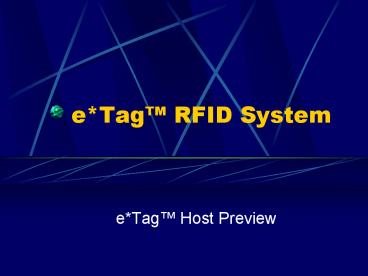eTag RFID System - PowerPoint PPT Presentation
1 / 33
Title:
eTag RFID System
Description:
A graphic user interface designed to demonstrate the commands and responses ... helps systems integrators and software designers to evaluate the capabilities of ... – PowerPoint PPT presentation
Number of Views:185
Avg rating:3.0/5.0
Title: eTag RFID System
1
eTag RFID System
- eTag Host Preview
2
What is eTag Host?
- A graphic user interface designed to demonstrate
the commands and responses available in eTag
reader/writers. - eTag Host helps systems integrators and
software designers to evaluate the capabilities
of eTag RFID systems.
3
Launch eTag Host from desktop.
4
Click on Version to see reader information.
This is also an easy way to confirm that you are
communicating with the reader.
5
Click on Setup to see how the reader is
currently set to function.
6
Select the Tag-it tab if you are working with
original T.I. Tag-it transponders and your reader
supports this mode.
7
Select the ISO/IEC 15693 tab if you are working
with ISO 15693-compliant transponders.
8
Wiegand Mode
Wiegand Communications is commonly used for
security access control applications. When placed
in a Wiegand mode eTag readers will
automatically read any transponders that enter
the field and transmit card data to a host.
9
To place the reader in the automatic Wiegand
mode, click on Wiegand.
10
Use the selector to choose the Wiegand mode you
want. UID modes read only the unique factory data
on the tag. Card Data mode reads encrypted data
that has been written on certain blocks of the
card.
11
When a reader is in a Wiegand UID mode, the
unique identification number and the reader
serial number are sent in ASCII format on the
RS-485 lines and the unique identifier is sent in
the selected Wiegand format on the Wiegand lines.
12
Go to Configuration and Encryption if you
want to change the Wiegand encryption key.
13
The revised Wiegand setup is displayed.
14
Read / Write Mode
In the read/write mode, data can be read from the
transponder and new data can be written on the
transponder. Read/write functions are used in a
variety of Automatic Identification and Data
Collection applications. When you select any
read/write operation the reader will be taken out
of Wiegand mode.
15
Select View One Block to read the data on a
single block.
Click on GO to execute the command once.
16
Select Continuous then click Go to repeat the
command continuously. Click Pause to interrupt
the continuous command.
17
Select View Many Blocks to see data on a group
of blocks. Up to 32 blocks may be read at one
time.
Enter the starting block and the number of blocks
to be read
18
Select View Factory Data to see the
transponders Unique I.D., and other information.
19
Select Program One Block to write data on a
single block.
Enter the block to be written and the data in
hexidecimal format.
20
Select Lock One Block to lock the data written
on a block.
Once locked, this data cannot be changed or
erased.
21
Select View Lock Status to see which blocks
have been locked.
22
Select Program AFI to Choose an Application
Field Identifier.
The AFI can be used as a filter to ignore any
transponders that are not intended for use in
your type of application.
23
Select Lock AFI to make the selected AFI
permanent.
24
Select Program DSFID to set a Developer
Selected Field Identifier.
DFSID can be used to convey custom information
specific to the application.
25
Select Lock DSFID to make the DSFID permanent.
26
Select Inventory to view the UID of several
transponders at once.
27
Go to Configuration and DeBug Mode to view
all host interface dialog at the bottom of the
screen.
28
Go to Configuration and LED/Audio to set LED
and buzzer modes.
29
Go to Configuration, Address Reader to
designate the serial number of a specific reader
you want to communicate with.
30
eTag Host Summary
- eTag Host has been designed to demonstrate the
various functions of eTag reader/writers. In
Wiegand mode these readers automatically detect
transponders and transmit data to a host in a
binary format.
31
eTag Host Summary
- In read/write mode a host can obtain data from
transponders as well as write new data on them.
Data is sorted by blocks. Data can be permanent
(locked) or changeable.
32
eTag Host Summary
- Application-specific software can be written to
use eTag in a variety of Automatic
Identification and Data Collection environments. - An Application Program Interface (API) and an
open communications protocol are provided with
the eTag development kits.
33
eTag RFID System
- RFID For Todays World































